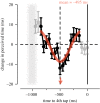Rhythmic motor behaviour influences perception of visual time
- PMID: 30282654
- PMCID: PMC6191697
- DOI: 10.1098/rspb.2018.1597
Rhythmic motor behaviour influences perception of visual time
Abstract
Temporal processing is fundamental for an accurate synchronization between motor behaviour and sensory processing. Here, we investigate how motor timing during rhythmic tapping influences perception of visual time. Participants listen to a sequence of four auditory tones played at 1 Hz and continue the sequence (without auditory stimulation) by tapping four times with their finger. During finger tapping, they are presented with an empty visual interval and are asked to judge its length compared to a previously internalized interval of 150 ms. The visual temporal estimates show non-monotonic changes locked to the finger tapping: perceived time is maximally expanded at halftime between the two consecutive finger taps, and maximally compressed near tap onsets. Importantly, the temporal dynamics of the perceptual time distortion scales linearly with the timing of the motor tapping, with maximal expansion always being anchored to the centre of the inter-tap interval. These results reveal an intrinsic coupling between distortion of perceptual time and production of self-timed motor rhythms, suggesting the existence of a timing mechanism that keeps perception and action accurately synchronized.
Keywords: action–perception coupling; finger tapping; sensorimotor; time perception; timing.
© 2018 The Author(s).
Conflict of interest statement
We declare we have no competing interests.
Figures





References
-
- Merchant H, Yarrow K. 2016. How the motor system both encodes and influences our sense of time. Curr. Opin. Behav. Sci. 8, 22–27. (10.1016/j.cobeha.2016.01.006) - DOI
Publication types
MeSH terms
Associated data
LinkOut - more resources
Full Text Sources
Other Literature Sources
Miscellaneous

